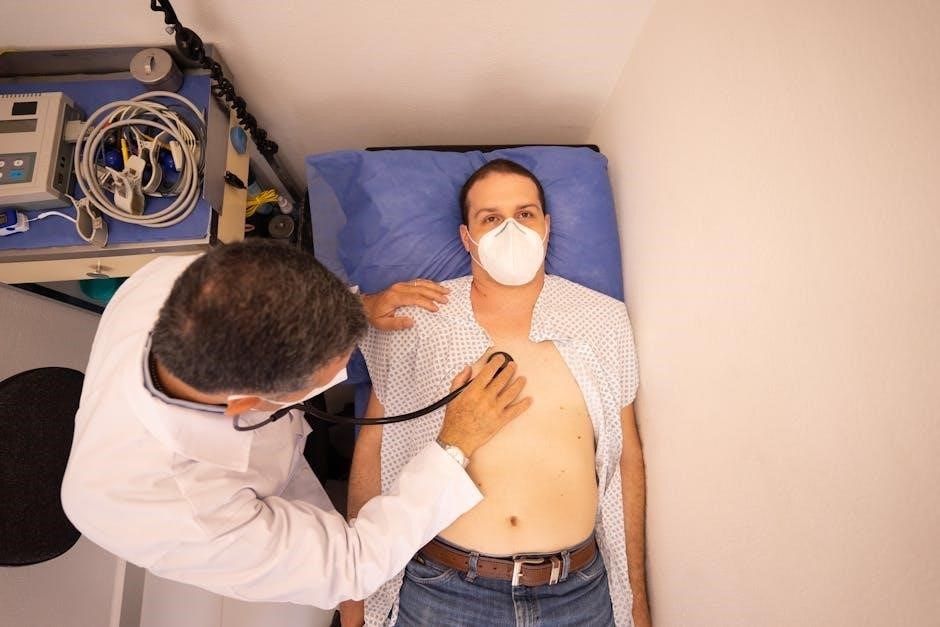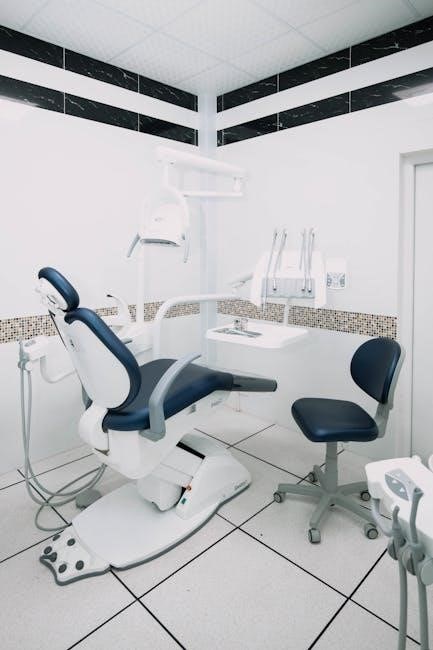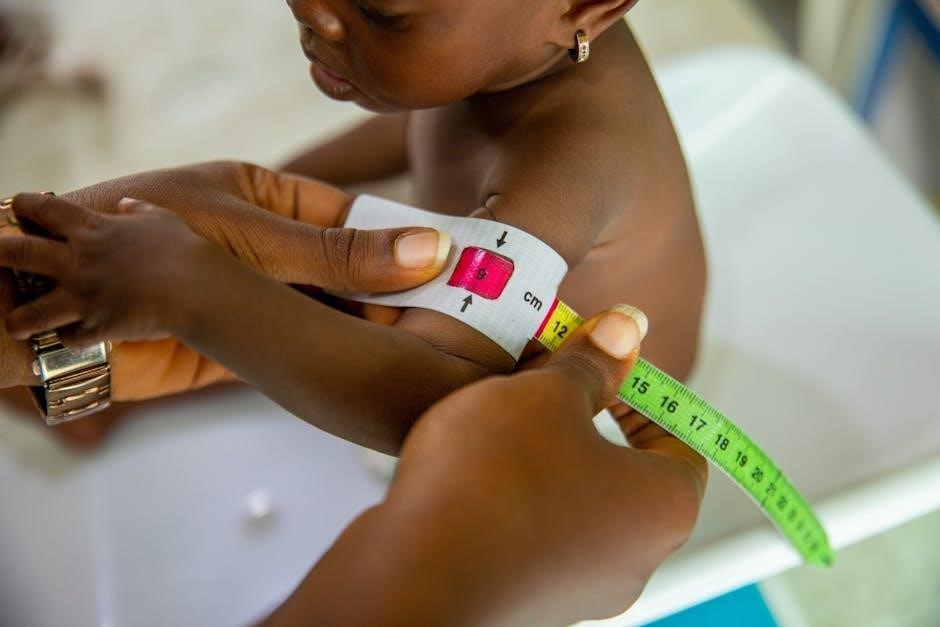Pediatric physical examination requires accuracy and consistency‚ with portability being key‚ as seen in the handbook‚ for nurse practitioners and primary care providers to assess children‚ using a step-by-step guide effectively always․
Importance of Accurate Examination
The importance of accurate examination in pediatric physical examination cannot be overstated‚ as it is crucial for providing effective care to children․ A thorough examination helps to identify any potential health issues early on‚ allowing for prompt treatment and preventing long-term damage․ According to the handbook‚ accuracy and consistency are key components of a successful examination‚ and using a step-by-step guide can help to ensure that all necessary steps are taken․ By following a systematic approach‚ healthcare providers can gather all relevant information and make informed decisions about patient care․ The use of visual aids‚ such as images and diagrams‚ can also help to improve the accuracy of the examination‚ as seen in the pediatric physical examination pdf․ This approach enables healthcare providers to provide high-quality care to children‚ which is essential for their overall health and well-being‚ and is a key aspect of pediatric care․
Overview of Pediatric Physical Examination Handbook
The Pediatric Physical Examination Handbook is a comprehensive guide that provides healthcare providers with the necessary tools to conduct thorough physical examinations of children․ The handbook is spiral-bound‚ making it easy to reference in clinical settings‚ and features a photo-rich‚ step-by-step guide to physical examination․ According to the pediatric physical examination pdf‚ the handbook covers the unique range of skills required to assess children of all ages‚ from birth through adolescence․ The handbook is written for students‚ educators‚ and pediatric healthcare providers‚ and is dedicated to mastering the art and technique of the comprehensive physical examination․ The guide includes body system chapters that begin with fetal development and take the reader through the key developmental stages of childhood‚ providing a detailed and thorough understanding of pediatric physical examination․ This handbook is a valuable resource for healthcare providers working with children․

Preparation for Physical Examination
Healthcare providers prepare for pediatric physical examination using guides and handbooks to ensure accurate assessment of children always effectively․
Understanding Developmental Stages
Understanding developmental stages is crucial in pediatric physical examination‚ as it enables healthcare providers to assess children’s growth and development accurately․ The handbook provides a comprehensive guide to developmental stages‚ from fetal development to adolescence․ Each stage has unique characteristics‚ and healthcare providers need to be aware of these to identify any abnormalities or delays․ The handbook includes chapters on body system development‚ which cover the key developmental stages of childhood․ By understanding these stages‚ healthcare providers can tailor their physical examination to the individual child’s needs‚ ensuring a thorough and effective assessment․ This knowledge is essential for healthcare providers to provide high-quality care to children‚ and the handbook is a valuable resource in this regard‚ providing useful information and techniques for assessing children’s development․ Effective assessment requires a thorough understanding of developmental stages․
Key Components of Physical Examination
The key components of physical examination in pediatric care include a thorough assessment of the child’s overall health‚ using a step-by-step approach․ This involves inspecting‚ palpating‚ percussing‚ and auscultating various body systems‚ including the cardiovascular‚ respiratory‚ and neurological systems․ The examination should also include an assessment of the child’s vital signs‚ such as temperature‚ pulse‚ and blood pressure․ Additionally‚ healthcare providers should evaluate the child’s developmental milestones‚ such as gross and fine motor skills‚ language development‚ and social skills․ The use of illustrations and photos can help healthcare providers to identify normal and abnormal findings‚ and to document their observations accurately․ By including these key components‚ healthcare providers can ensure a comprehensive and thorough physical examination‚ which is essential for providing high-quality care to children․ The examination should be tailored to the child’s age and developmental stage․

Conducting the Physical Examination
Conducting physical examinations requires a systematic approach‚ using various techniques to assess pediatric patients effectively always with great care and patience every time․
Body System Chapters and Fetal Development
The handbook provides comprehensive body system chapters‚ starting with fetal development and progressing through childhood‚ offering a detailed understanding of pediatric physical examination․ Each chapter is designed to guide healthcare providers in assessing pediatric patients‚ from birth through adolescence‚ using a step-by-step approach․ The inclusion of fetal development in the body system chapters allows for a deeper understanding of the origins of various physical characteristics and potential health issues․ This information is essential for nurse practitioners and primary care providers‚ as it enables them to identify potential health problems early on and provide appropriate care․ By following the guidelines outlined in the handbook‚ healthcare providers can develop the skills necessary to conduct thorough physical examinations‚ ultimately improving patient outcomes․ The body system chapters are organized in a logical and easy-to-follow manner‚ making it simple for healthcare providers to access the information they need․
Telehealth and Its Role in Pediatric Examination
Telehealth is increasingly being used in pediatric examination‚ allowing healthcare providers to remotely assess and manage pediatric patients․ The handbook includes new sections on telehealth‚ providing guidance on how to effectively use this technology in pediatric care․ With telehealth‚ healthcare providers can conduct virtual physical examinations‚ reducing the need for in-person visits and improving access to care for pediatric patients․ This is particularly useful for patients in rural or underserved areas‚ where access to healthcare may be limited; The use of telehealth in pediatric examination also enables healthcare providers to monitor patients remotely‚ reducing the risk of hospitalization and improving health outcomes․ By incorporating telehealth into pediatric care‚ healthcare providers can provide more convenient and effective care for their patients‚ ultimately improving the quality of care and patient satisfaction․ The handbook provides valuable insights into the role of telehealth in pediatric examination․

Special Considerations in Pediatric Examination
Special considerations are necessary when examining pediatric patients‚ using a gentle and child-friendly approach always and effectively․
Pediatric Clinical Pearls and Useful Techniques
Pediatric clinical pearls and useful techniques are essential for healthcare providers to master‚ as they provide valuable insights and practical tips for assessing and managing pediatric patients․ The handbook provides a comprehensive collection of these pearls and techniques‚ covering various aspects of pediatric physical examination․ By using these techniques‚ healthcare providers can improve their skills and confidence in examining pediatric patients‚ leading to better health outcomes․ The techniques outlined in the handbook are based on the latest research and evidence-based practices‚ ensuring that healthcare providers have access to the most up-to-date and effective methods for assessing and managing pediatric patients․ The handbook also includes case studies and examples to illustrate the application of these techniques in real-world settings‚ making it a valuable resource for healthcare providers․ Overall‚ the pediatric clinical pearls and useful techniques presented in the handbook are a valuable resource for healthcare providers․
Age-Specific Variations in Pediatric Examination
Age-specific variations in pediatric examination are crucial to consider‚ as children’s physical and developmental needs change significantly as they grow․ The handbook provides guidance on how to adapt the physical examination to the child’s age‚ from infancy to adolescence․ Different age groups require unique approaches‚ and the handbook outlines these variations in detail․ For example‚ infants require a gentle and comforting approach‚ while older children may require more explanation and involvement in the examination process․ The handbook also discusses the importance of considering developmental milestones and age-specific norms when interpreting physical examination findings․ By taking into account these age-specific variations‚ healthcare providers can ensure that they are providing comprehensive and effective care to their pediatric patients․ The handbook’s discussion of age-specific variations is a valuable resource for healthcare providers working with children of all ages․ Healthcare providers can use this information to improve their practice․

and Future Directions
The pediatric physical examination is a crucial aspect of healthcare‚ and the handbook provides a comprehensive guide for healthcare providers․ In conclusion‚ the handbook is a valuable resource for those working with children‚ offering a step-by-step approach to physical examination․ The future of pediatric physical examination will likely involve the integration of telehealth and other technologies to improve access to care․ As healthcare continues to evolve‚ it is essential to stay up-to-date with the latest developments and best practices in pediatric physical examination․ The handbook will continue to be a vital tool for healthcare providers‚ and its guidance will help shape the future of pediatric care․ By following the handbook’s recommendations‚ healthcare providers can ensure that they are providing high-quality care to their pediatric patients․ The handbook’s impact will be significant‚ and its influence will be felt for years to come‚ shaping the future of pediatric physical examination and care․
